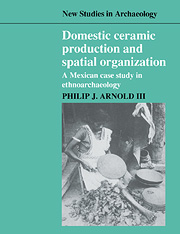Book contents
- Frontmatter
- Contents
- List of figures
- List of tables
- Acknowledgements
- 1 Introduction
- Part 1 Ceramic production and consumption in Los Tuxtlas
- Part 2 Ceramic production and spatial organization
- 5 Archaeological approaches to ceramic production
- 6 Spatial organization and ceramic production
- 7 Disposal patterns within production houselots
- Part 3 Application and implication
- References
- Index
7 - Disposal patterns within production houselots
Published online by Cambridge University Press: 02 December 2009
- Frontmatter
- Contents
- List of figures
- List of tables
- Acknowledgements
- 1 Introduction
- Part 1 Ceramic production and consumption in Los Tuxtlas
- Part 2 Ceramic production and spatial organization
- 5 Archaeological approaches to ceramic production
- 6 Spatial organization and ceramic production
- 7 Disposal patterns within production houselots
- Part 3 Application and implication
- References
- Index
Summary
The previous chapter established that firing variability correlates with differences in spatial pressure at the houselot level. As space becomes less available in sedentary settings there will be a need to restructure activity organization and begin intensifying the use of space within the compound. The process of activity restriction was presented in terms of the transition from open-air firing to kiln firing. As long as sufficient space was available, open firing would provide a locational response to microenvironmental variability. When spatial flexibility was no longer an option, a technological response to controlling firing conditions was observed.
If this relationship is accurate, then material patterns unrelated to ceramic production should be similarly affected. In other words, spatial constraints should be regulating a variety of activities, not just pottery manufacture. If comparable associations between areal availability and non-production organization are indicated, then the emphasis placed on space as a crucial resource in ceramic production would be supported.
This chapter discusses houselot maintenance in terms of spatial pressure and organization. When there is little pressure on spatial resources, maintenance is expected to be less intensive and the maintenance regime should display a broader, more extensive patterning in material distributions (e.g. Hayden and Cannon 1983:156). As areal pressure intensifies, however, activity areas should be maintained in a more intensive fashion (e.g. Schiffer 1987:59). By extending the behavioral expectations in this manner, this discussion provides additional corroboration for the organizational perspective adopted in this research.
- Type
- Chapter
- Information
- Domestic Ceramic Production and Spatial OrganizationA Mexican Case Study in Ethnoarchaeology, pp. 120 - 138Publisher: Cambridge University PressPrint publication year: 1991

